When the first M1-based Macs were released in the fall of 2020, it’s no exaggeration to say they shook up the entire computer market. Apple took the basic architecture of the A14 (found in the iPhone 12), scaled it up to ultraportable laptop levels, and blew away the competition. It was fast, very fast, and provided shockingly good battery life. With the M1 Pro and M1 Max in 2021, Apple scaled the architecture up further to performance laptops (and presumably upcoming desktops), and again became the processor against which all others were compared.
The only chips that outperform the M1 Max are Intel’s Alder Lake processors, and then only with a bunch of caveats about a massive disparity in power consumption, only running full speed when plugged in, and leaning on a high-power Nvidia GPU.
So what does Apple do for an encore? With the M1 now almost a year and a half old, it’s time for its successor, which we’ll assume will be called the M2. While we never really know what Apple has up its sleeve until products are announced (as early as March or at WWDC in June or later this fall), but we’re going to take out best educated guess about what we can expect from the M2 (and we’ll throw in an M2 Max prediction, too).
M2 is to M1 as A15 is to A14
The M1 is based on the basic architecture of the A14, scaled up with double the number of high-performance CPU cores (four instead of two) and double the GPU cores (eight instead of four). It is, for lack of a better explanation, the “A14X” that otherwise would’ve been in the iPad Pro.
In trying to predict the M2’s features and performance, we will operate on the assumption that it will follow a similar pattern, only this time with the A15: the same architecture with twice the high-performance cores and GPU cores. Note that the A15 actually has five GPU cores, with the fifth one enabled only in the iPhone 13 Pro models. We’ll generate performance expectations with a doubling of that to 10 cores, which jibes with rumors about the M2’s configuration.
For the M2 Max, we assume the same scaling-up as from the M1 to M1 Max. The CPU cores will be swapped out for a 2-efficiency, 8-performance setup, and GPU cores will be quadrupled from the base M1 chip (for a total of 40).
Improved manufacturing process
Before we get to the numbers, we should mention that it is expected for the M2 to be manufactured on TSMC’s N4P process, which is an enhanced form of the 5nm process on which the A14 and M1 were manufactured. TSMC claims that it can run up to 11 percent faster at the same power, or use 22 percent less power at the same performance. It’s not really known if this will translate into higher clock speeds, better battery life, or a little bit of both. It all depends on Apple’s particular configuration, and battery life in particular is subject to a wide number of variables (like how power-efficient the display is, for example).
For our performance predictions here, we are not factoring in additional performance from manufacturing process improvements, as there is no way to realistically quantify what they might be. It is reasonable to expect that the figures provided here are probably a few percent lower than what Apple might squeeze out of the N4P process, and just as we saw greatly improved battery life in the A15-powered iPhone 13 phones, Apple may prioritize longevity in the MacBooks that use these chips.
M2 and M2 Max CPU estimates
We started by looking at how much faster the A15 is than the A14, which has a similar four-efficiency and two-performance CPU core configuration, but a number of architectural improvements. In all, the A15’s single-core performance is about 7 percent higher than the A14.
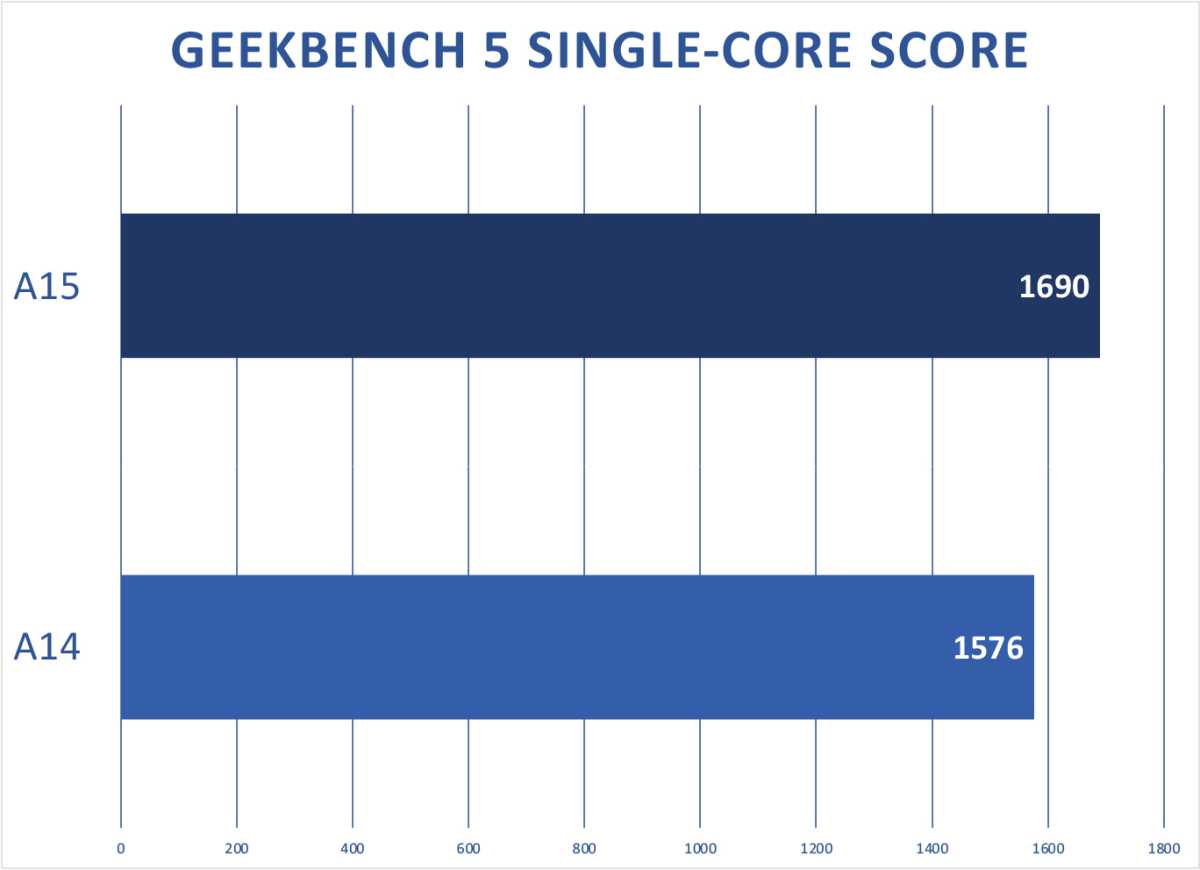
IDG
The multi-core score is much higher, at 20 percent, despite the same core configuration. Apple likely made architectural improvements to improve the use of all cores at once, and the manufacturing process improvements may be able to maintain higher clock speeds when all cores are active.
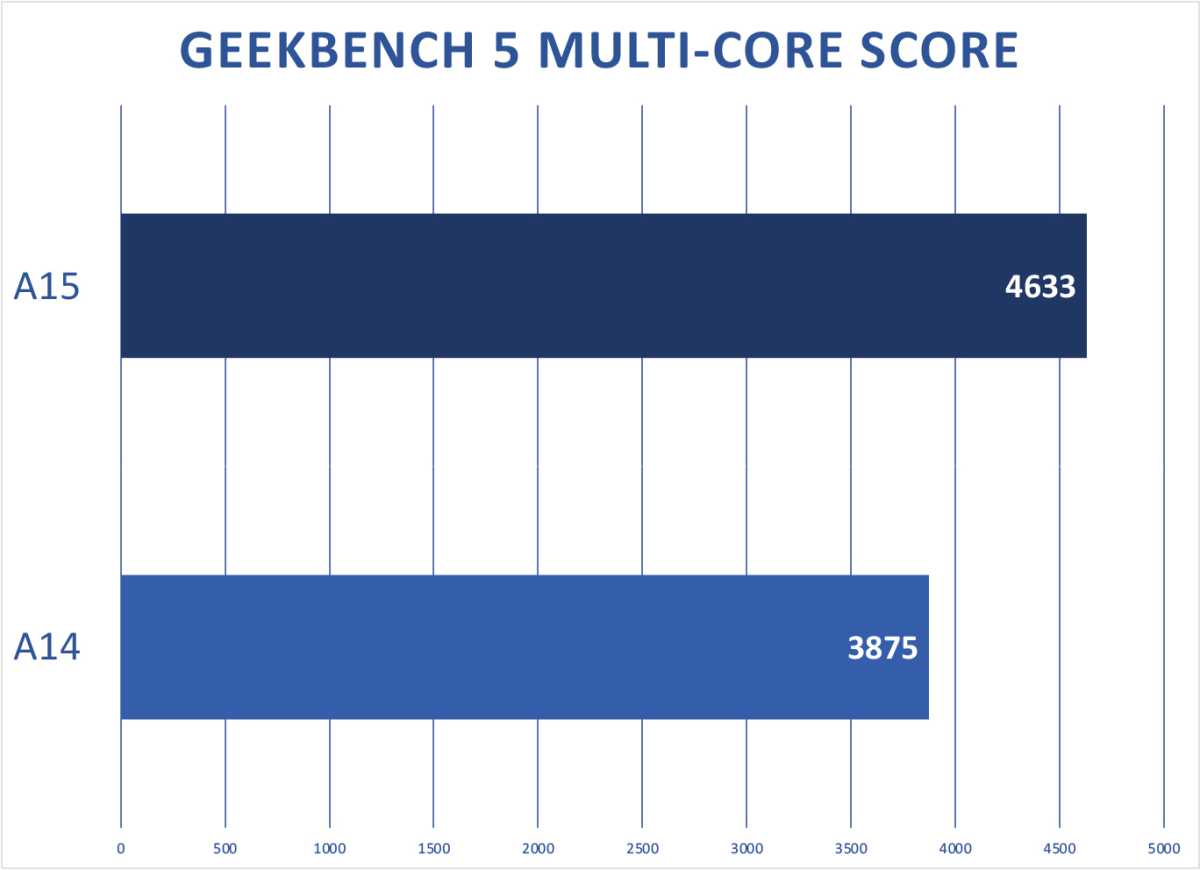
IDG
When we take the M1 and M1 Max scores and add that same performance boost, we get some impressive numbers. Single-core performance is likely to top 1,800 in Geekbench 5, which is on par with Intel’s upcoming Core i9 Alder Lake high-performance laptop chip.

IDG
It’s the multi-core score that could get very interesting. Rumors say the M2 will have the same four-efficiency, four-performance layout as the M1, while the M2 Max sticks with four efficiency cores and eight performance cores like the M1 Max.
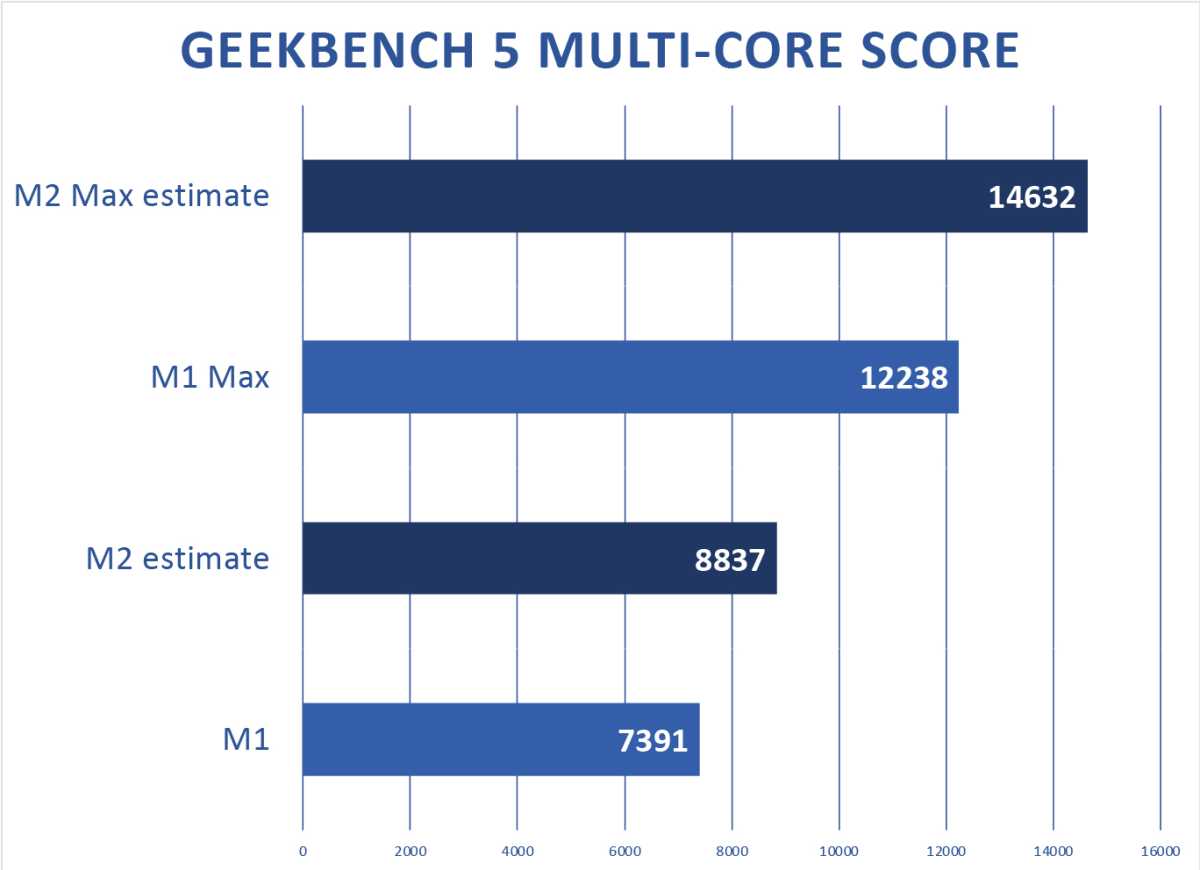
IDG
That could generate scores just under 9,000 for the M2 (still not as fast as the M1 Max, thanks to that chip having eight high-performance cores). That’s a great score for ultraportable laptops like the MacBook Air. But a score well over 14,000 for the M2 Max would put it ahead of the Intel’s fastest Alder Lake Core i9, which has 14 cores (six performance and eight efficiency). And it’s likely that the M2 Max achieves those performance gains at a fraction of the power.
M2 and M2 Max graphics estimates
As with our CPU projections, we estimate M2 graphics performance by simply looking at the performance uplift from the A14 to the A15 (in the iPhone Pro models) and assuming the same uplift from the M1 to the M2. The A15 has 25 percent more GPU cores than the A14 (five instead of four), but the extra core is only enabled in the iPhone 13 Pro phones. Rumor has it that the M2 will go from a maximum of eight GPU cores to 10, and the M2 Max from 32 to 40, keeping this ratio intact.

IDG
3DMark’s Sling Shot benchmark is a little dated, but still a reasonably useful measure of how well the GPU performs when running simpler, older graphics technologies. The A15 is 24 percent faster than the A14. You can chalk that up to having 25 percent more cores along with some architectural improvements.
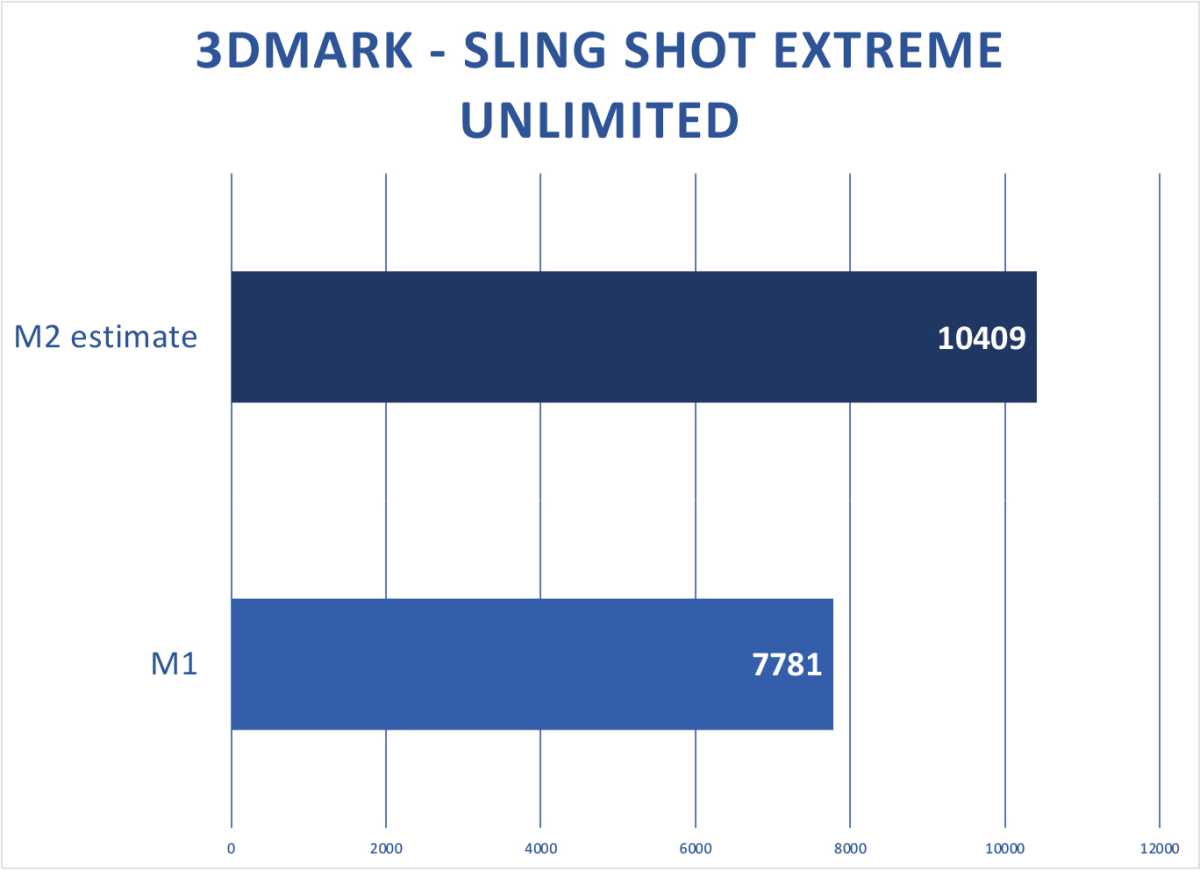
IDG
Unfortunately, the Sling Shot test is only available for mobile platforms. That means that we can’t test it on the M1 Max, as that chip is only available in MacBooks. But as the M1 can be found in the iPad Pro, we can run this useful but somewhat aging benchmark on the M1 and surmise that we might see a score over 10,000 with the M2, which would readily put any other modern tablet to shame.
A more modern cross-platform test is 3DMark’s new Wild Life. In the most strenuous version of this test, the A15 is 30 percent faster than the A14.
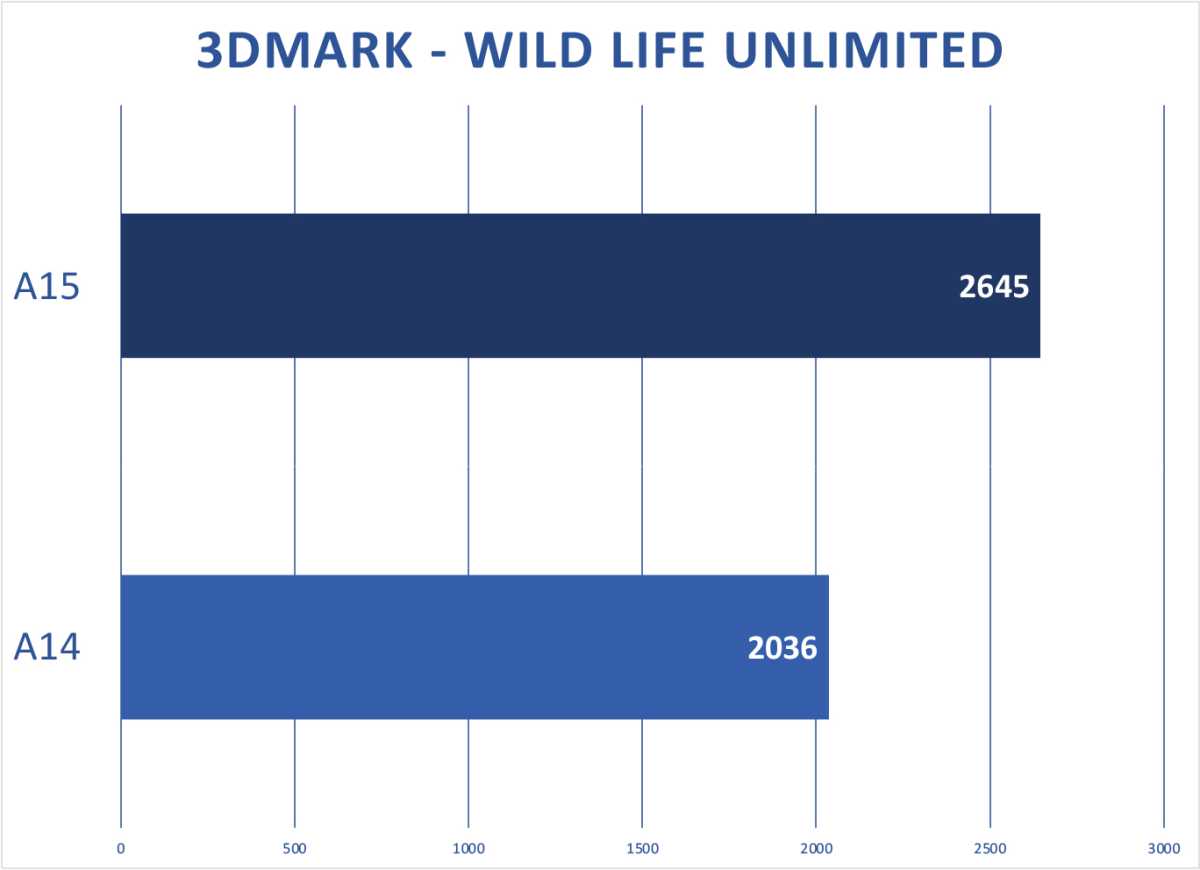
IDG
Scaling up to the M2 and M2 Max, we could expect over 6,000 for the lower-performance chip, and over 26,000 for Apple’s most powerful processor. That latter score is worth taking note of, as it’s pretty close to the mobile variant of the GeForce GTX 3070.
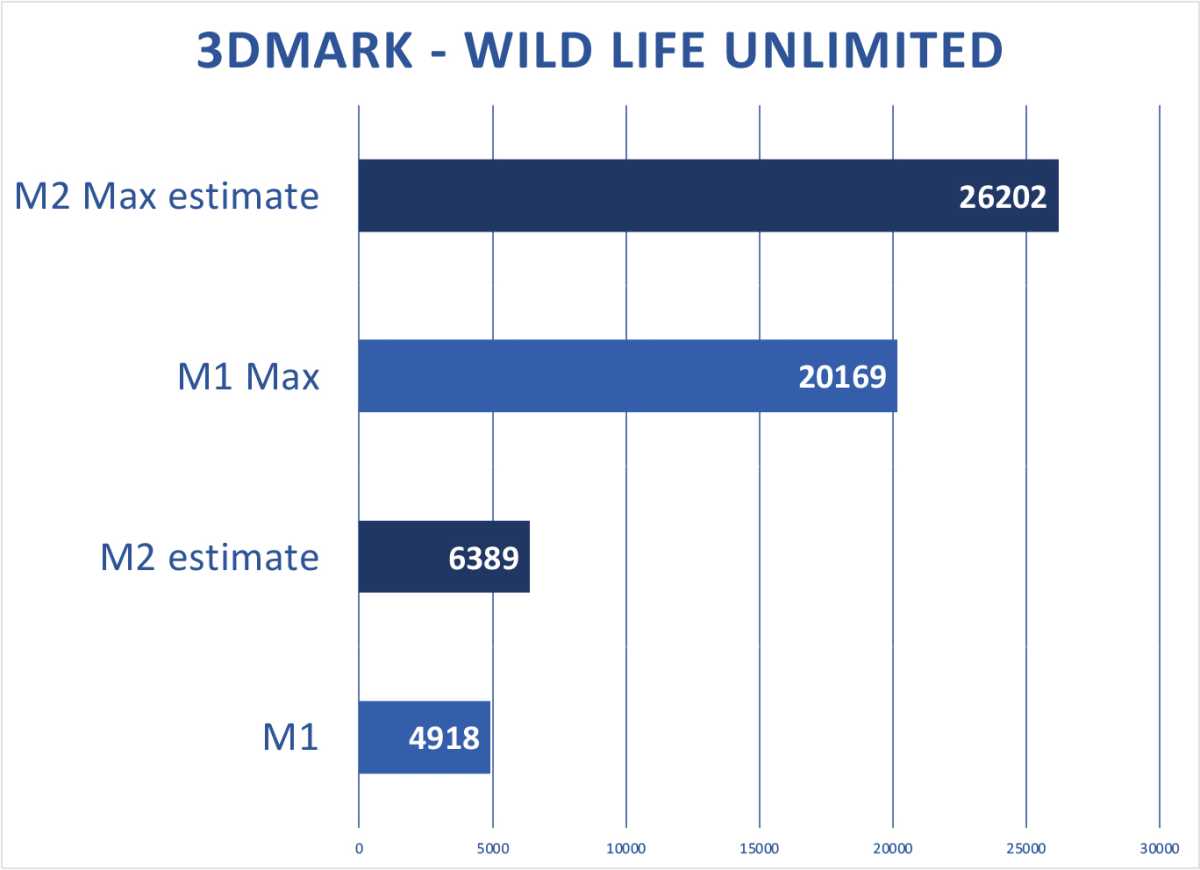
IDG
While such an increase in performance would bring the M2 Max in line with a fairly high-end mobile discrete GPU, it’s still not even half the performance of a top of the line desktop GPU. More importantly, serious high-end GPUs from AMD and Nvidia (and the coming Arc series from Intel) feature hardware accelerated ray tracing, which is absent from Apple’s GPUs so far. While I think support for such a feature will have to happen sooner or later, it’s probably not going to arrive in the M2 line. Apple is already years behind the competition there, and it’s not likely going to improve this year.
Other considerations: Neural Engine, video encoder, memory
While the CPU and GPU are easy to quantify, they’re not the only important parts of Apple’s system-on-chips. RAM is of course very important, and we expect high-speed LPDDR5 to feature prominently again in these chips, as it provides the right mix of performance and power efficiency. Apple has done a great job of making sure their chips have enough memory bandwidth to fully utilize their CPU cores and GPU cores, and we don’t see any reason why it would let the M2 (or M2 Max) be the first to be seriously constrained by bandwidth.
The Neural Engine, a custom processor block designed to accelerate machine learning and AI tasks, and while the A15 has a 16-core Neural Engine just like the A14, it has been redesigned for better efficiency and can perform more than 40 percent more operations per second. We expect this same Neural Engine to make the leap to the M2.
Lastly, the A15 features an improved its video processing engine, which speeds up video decoding and encoding. The M1 and M1 Pro has one of these, while the M1 Max has two. We wouldn’t be at all surprised to find this continues with the M2—a single improved video engine in the M2 and M2 Pro, and two of them in the M2 Max. It would be nice to see further improvement here, since Macs are so often used as video production machines. In particular, Apple’s SoCs do not yet have hardware support for the AV1 code (neither encoding nor decoding), and it would be great to see this added in the M2’s version of the video processing engine.
Overall expectations
While it’s exciting to think that the M2 might be some major architectural upheaval, it’s most likely that it will carry forward the technology of the A15 in exactly the same way that the M1 derives from the A14. Perhaps Apple will diverge its Mac silicon further from its A series architecture even more in the future, but in its second-generation chip, “the A15 scaled up in exactly the same way” is the most likely scenario.
Performance limitations will vary wildly depending on the task or benchmark at hand, and factors like SSD performance and cooling always play a role. But in general terms, we think it’s reasonable to expect approximately 20 percent better CPU performance (and less than 10 percent on a single core), while the addition of extra cores will bring GPU performance up about 30 percent. These improvements will be accompanied by improved machine learning and video encoding performance, too.
All of this should happen in roughly the same power envelope, too. Apple rarely backslides on battery life, so you can expect similar laptops with M2 chips to have the same or better battery life while delivering these impressive performance gains. And since Apple prioritized battery life with the A15 chip, it could get a whole lot better.
I have written professionally about technology for my entire adult professional life – over 20 years. I like to figure out how complicated technology works and explain it in a way anyone can understand.




